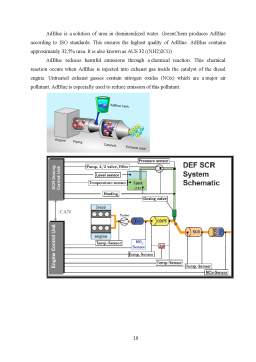Cuprins
- Automotive industry 3
- History 3
- Present 4
- Looking to the future 4
- Chemistry Industry 5
- History 5
- Let’s talk about environment! 6
- How it all began... 7
- INNOVATIVE SYSTEMS of Automotive Industry 7
- Selective catalytic reduction 7
- Chemistry 8
- System description 9
- Bibliography 11
Extras din proiect
In this project i will try to show how two industry combine their resources to create a product, more exactly one innovative system for Euro 6 cars.
I will present further these two industries, to understand exactly what these do.
Automotive industry
The automotive industry designs, develops, manufactures, markets, and sells motor vehicles, and is one of the Earth's most important economic sectors by revenue.
The term automotive industry usually does not include industries dedicated to automobiles after delivery to the customer.
The automotive industry is therefore central to Europe's prosperity. It is a huge employer of skilled workforce and a key driver of knowledge and innovation. It represents Europe's largest private investor in research and development (R&D). It also makes a major contribution to EU's Gross Domestic Product (GDP), and exports far more than it imports.
History
The diesel engine has a storied past and a bright future. Invent¬ed more than 100 years ago as a stationary power source, it has become the undisputed workhorse for shipping and trucking ap¬plications worldwide.
The first practical automobile with a petrol engine was built by Karl Benz in 1885 in Mannheim, Germany. Benz was granted a patent for his automobile on 29 January 1886, and began the first production of automobiles in 1888, after Bertha Benz, his wife, had proved with the first long-distance trip in August 1888 (104 km from Mannheim to Pforzheim and back) that the horseless coach was absolutely suitable for daily use.
Soon after, in 1889, Gottlieb Daimler and Wilhelm Maybach in Stuttgart designed a vehicle from scratch to be an automobile, rather than a horse-drawn carriage fitted with an engine.
In 1893, German engineer Rudolf Diesel received a patent for a new internal combustion engine designed to be much more effi¬cient than steam engines of the time and to use a variety of fuels, from coal dust to vegetable oils. In 1897, the first public demonstra¬tion of a working diesel engine involved a 20-horsepower model weighing more than four tons
Diesel’s engine used a different combustion cycle than that of the spark-ignition engine invented by his contemporary, Niko¬laus Otto. Both cycles consist of four piston strokes: intake, compression, power, and exhaust. However, they differ in how the fuel is supplied and ignited. In a typical gasoline spark-ignition engine without direct injection, the fuel is premixed with air and introduced into the cylinder during the intake stroke. Combustion begins when an electric spark ignites the fuel-air mixture late in the compression stroke.
Present
Today’s vehicles are graded on stricter and more precise parameters than ever before from weight to safety to durability and anywhere and everywhere in between. New materials have brought out new techniques for construction and vehicle design. The introduction of plastics has advanced the technology used for making newer vehicles. New plastics technologies allow manufactures to answer to the call for advancements. Plastics can be used in various technologies on vehicles for structural safety to visual appearance. These new plastic innovations allow new technologies to be used in vehicles for safety to comfort purposes. Plastics also allow for cost effective changes to be made to newer vehicle while still maintaining high safety and comfort requirements of the industry. These advancements in plastic material usage in modern vehicles are the footholds for the future of the automotive industry.
Today’s diesel engines are much more advanced than those of just a decade ago—and tremendously improved compared with the unreliable, noisy, and polluting vehicles of the 1970s. Mod¬ern diesel engines are predominantly direct-injection, four-stroke engines with electronic controls that offer high efficiency, quiet operation, and low emissions.
They are available in a wide variety of sizes for on- and non-road vehicles, from about 20 horsepower for agricul¬tural and turf maintenance equipment to 3,000 horsepower or more for non-road equipment such as dump trucks.
Looking to the future
With their distinguished track record and inherent power and ef¬ficiency advantages, diesel engines are poised to meet the demands of the future. These demands include minimizing petroleum use, CO2 emissions, and regulated emissions. Stricter emissions regula-tions may lead to widespread use of novel diesel emission-control technologies, and even entirely new combustion regimes (such as low-temperature combustion) are possible. The diesel engine must also adapt to new fuels such as biodiesel and synthetic diesel.
Preview document
Conținut arhivă zip
- Innovative Industry.docx






















